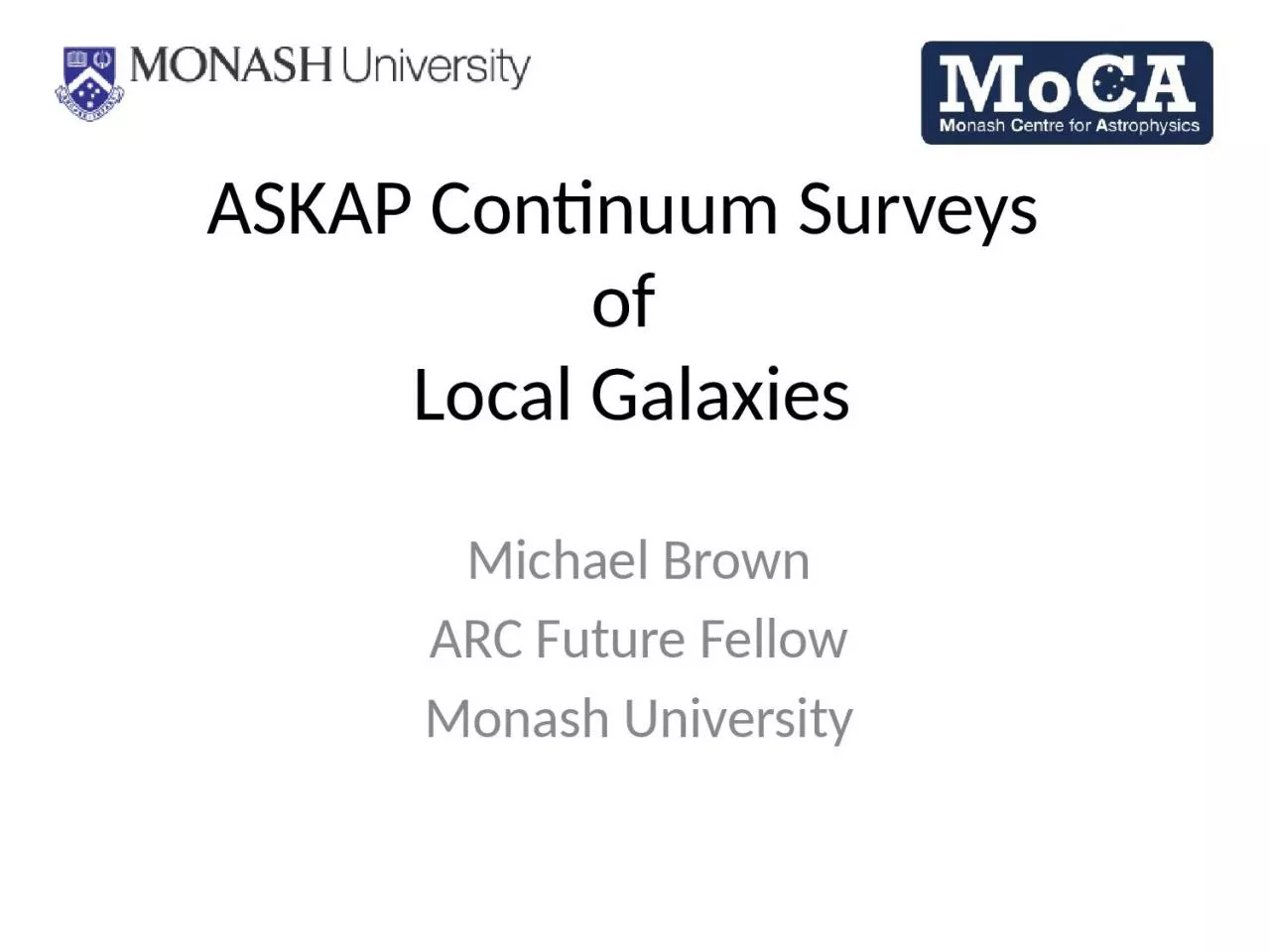

of Local Galaxies Michael Brown ARC Future Fellow Monash University Where are we now NVSS FIRST SUMMS 05 mJy RMS per beam 151 beam 30 uJy RMS per beam in 12 hours ID: 1034361
Download Presentation The PPT/PDF document "ASKAP Continuum S urveys" is the property of its rightful owner. Permission is granted to download and print the materials on this web site for personal, non-commercial use only, and to display it on your personal computer provided you do not modify the materials and that you retain all copyright notices contained in the materials. By downloading content from our website, you accept the terms of this agreement.
1. ASKAP Continuum Surveys of Local GalaxiesMichael BrownARC Future FellowMonash University
2. Where are we now?NVSS / FIRST / SUMMS0.5 mJy RMS per beam15”-1’ beam~30 uJy RMS per beam in 12 hours Future ASKAP 12
3. K<9 Spiral GalaxiesCatalogued sourcesFlux density perbeam from NVSS images
4. K<9 Early-type GalaxiesBrown et al. 2011
5. K<10.5 Spiral Galaxies & AGNsFloyd et al. (submitted)
6. Radio continuumContinuum detects “hot mode” AGNS.Continuum can be a good SFR indicatorHave we been misled by optical colours?Are SFR indicators properly calibrated? ASKAP ADE-12 is great for low z science!It will detect all* local galaxies (duty cycles, env).One galaxy per beam and with known locations.Spectroscopy, morphology, optical, mid-IRDone better with completed ASKAP but…
7. Galaxy Colour Bimodality
8. Galaxy Evolution
9. Bonne et al. (in prep.)K-band Absolute MagnitudeRed Spiral / Total Spiral
10. Kennicutt et al. 2009Corrected L HaL 1.4L 1.4 & L HaSFRIndicator
11. RescalingSpectraSpectra and H-alpha measurements from Moustakas et al. (2006, 2010) need to be increased by 10%.
12. UGCA 219NVSS 4.5 mJy Optical g=14.78
13. UGCA 166 g~16NVSS 2.0 mJy Optical g=16.05
14. Dolley et al. (in prep.)High star-formationLow star-formationGalaxy Clustering StrengthProjected spatial Scale
15. Are Red Spirals Forming Stars?KAB<10.5 spiral galaxiesBonne et al. (in prep) and Floyd et al. (sub.)NVSS 1.4 GHz as a star formation proxy1.4 GHz is not impacted by dust obscurationWISE mid-IR to search for warm dustDust is heated by star formation21-cm to search for neutral hydrogenCould star formation resume?
16. Sample SelectionKAB<10.5T-type > -1NVSS 1.4 GHz coverage228 galaxiesSelect galaxies with f1.4 < 2.5 mJy42 galaxies
17. SDSS Optical ColoursKAB<10.5 f1.4<2.5 mJyAll other spiral galaxies
18.
19. UV-optical similar to passive EH-alpha lost in the noiseSpiral arms are blue in UV-opticalIR excessRed and no NVSS, but Star Forming
20. Radio continuumContinuum detects “hot mode” AGNS.Continuum can be a good SFR indicatorHave we been misled by optical colours?Are SFR indicators properly calibrated? ASKAP ADE-12 is great for low z science!It will detect all* local galaxies (duty cycles, env).One galaxy per beam and with known locations.Spectroscopy, morphology, optical, mid-IRDone better with completed ASKAP but…
21.
22. NGC 2811 f1.4 < 2.5 mJyX
23. SummaryHave we been misled by colour bimodality?Red spirals are not faded blue spirals.Red spirals are brighter than blue spirals (Bonne).High and low SFR spirals live in similar halosThe large-scale clustering is similar (Dolley).Low SFR spirals are not passive spiralsInfrared excess and PAH emission Red spirals generally have HI
24.
25.
26. NVSSWISE 11 micronsSpitzer 24 micronsSDSS Optical
27. Infrared SEDsIR excess relative to passive elliptical galaxiesNGC 4725 spectrum shows PAH and dust emission
28. 21-cmCatalogued HI in redUncatalogued HI in black228 spirals with KAB < 10.5186 spirals in HI catalogues42 spirals f1.4 < 2.5 mJy31 spirals in HI catalogues
29. NGC 5188 f1.4=95 mJyX
30. NGC 7727 f1.4<2.5 mJyX